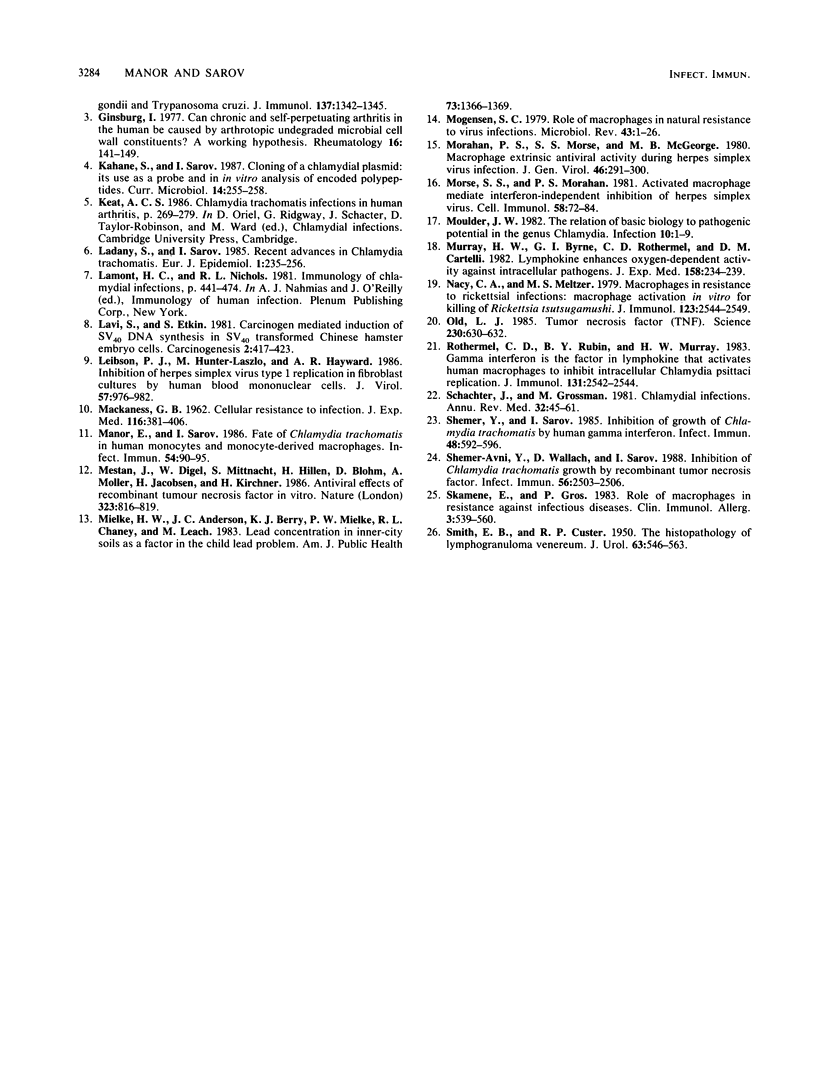Abstract
Monocytes (M) and macrophages are important components of the immune response to foreign agents. Using an in vitro system, we studied the influence of human M and M-derived macrophages (MdM) on the replication of Chlamydia trachomatis (L2/434) in HEp-2 cells. M or MdM were added to infected cells at a ratio of 4:1, and the resultant chlamydial yield was evaluated in one-step growth experiments. Chlamydial DNA production was evaluated by dot hybridization. Both M and MdM reduced chlamydial yield and DNA production, but the reductions caused by MdM were more pronounced. Electron microscopy showed that while control HEp-2 cells at 48 h postinfection contained large inclusions in which most particles were elementary bodies, the infected HEp-2 cells exposed to MdM contained small vacuoles with abnormal reticulate bodies and very few typical elementary bodies. Separation of the MdM from the HEp-2 cells by a membrane reduced the inhibitory effect of the MdM relative to that of MdM in direct contact with the infected cells. Addition of tumor necrosis factor antibodies to C. trachomatis-infected HEp-2 cells exposed to MdM (either in direct contact or separated by a membrane from the infected cells) reduced the inhibition of chlamydial DNA production. These data suggest the possibility that MdM may modulate C. trachomatis replication in vivo.
Full text
PDF




Images in this article
Selected References
These references are in PubMed. This may not be the complete list of references from this article.
- Armstrong J. A., Hart P. D. Phagosome-lysosome interactions in cultured macrophages infected with virulent tubercle bacilli. Reversal of the usual nonfusion pattern and observations on bacterial survival. J Exp Med. 1975 Jul 1;142(1):1–16. doi: 10.1084/jem.142.1.1. [DOI] [PMC free article] [PubMed] [Google Scholar]
- De Titto E. H., Catterall J. R., Remington J. S. Activity of recombinant tumor necrosis factor on Toxoplasma gondii and Trypanosoma cruzi. J Immunol. 1986 Aug 15;137(4):1342–1345. [PubMed] [Google Scholar]
- Ginsburg I. Can chronic and self-perpetuating arthritis in the human be caused by arthrotropic undegraded microbial cell wall constituants? A working hypothesis. Rheumatol Rehabil. 1977 Aug;16(3):141–149. doi: 10.1093/rheumatology/16.3.141. [DOI] [PubMed] [Google Scholar]
- Ladany S., Sarov I. Recent advances in Chlamydia trachomatis. Eur J Epidemiol. 1985 Dec;1(4):235–256. doi: 10.1007/BF00237099. [DOI] [PubMed] [Google Scholar]
- Lavi S., Etkin S. Carcinogen-mediated induction of SV40 DNA synthesis in SV40 transformed Chinese hamster embryo cells. Carcinogenesis. 1981;2(5):417–423. doi: 10.1093/carcin/2.5.417. [DOI] [PubMed] [Google Scholar]
- Leibson P. J., Hunter-Laszlo M., Hayward A. R. Inhibition of herpes simplex virus type 1 replication in fibroblast cultures by human blood mononuclear cells. J Virol. 1986 Mar;57(3):976–982. doi: 10.1128/jvi.57.3.976-982.1986. [DOI] [PMC free article] [PubMed] [Google Scholar]
- MACKANESS G. B. Cellular resistance to infection. J Exp Med. 1962 Sep 1;116:381–406. doi: 10.1084/jem.116.3.381. [DOI] [PMC free article] [PubMed] [Google Scholar]
- Manor E., Sarov I. Fate of Chlamydia trachomatis in human monocytes and monocyte-derived macrophages. Infect Immun. 1986 Oct;54(1):90–95. doi: 10.1128/iai.54.1.90-95.1986. [DOI] [PMC free article] [PubMed] [Google Scholar]
- Mestan J., Digel W., Mittnacht S., Hillen H., Blohm D., Möller A., Jacobsen H., Kirchner H. Antiviral effects of recombinant tumour necrosis factor in vitro. 1986 Oct 30-Nov 5Nature. 323(6091):816–819. doi: 10.1038/323816a0. [DOI] [PubMed] [Google Scholar]
- Mielke H. W., Anderson J. C., Berry K. J., Mielke P. W., Chaney R. L., Leech M. Lead concentrations in inner-city soils as a factor in the child lead problem. Am J Public Health. 1983 Dec;73(12):1366–1369. doi: 10.2105/ajph.73.12.1366. [DOI] [PMC free article] [PubMed] [Google Scholar]
- Mogensen S. C. Role of macrophages in natural resistance to virus infections. Microbiol Rev. 1979 Mar;43(1):1–26. doi: 10.1128/mr.43.1.1-26.1979. [DOI] [PMC free article] [PubMed] [Google Scholar]
- Morahan P. S., Morse S. S., McGeorge M. G. Macrophage extrinsic antiviral activity during herpes simplex virus infection. J Gen Virol. 1980 Feb;46(2):291–300. doi: 10.1099/0022-1317-46-2-291. [DOI] [PubMed] [Google Scholar]
- Morse S. S., Morahan P. S. Activated macrophages mediate interferon-independent inhibition of herpes simplex virus. Cell Immunol. 1981 Feb;58(1):72–84. doi: 10.1016/0008-8749(81)90150-7. [DOI] [PubMed] [Google Scholar]
- Murray H. W., Byrne G. I., Rothermel C. D., Cartelli D. M. Lymphokine enhances oxygen-independent activity against intracellular pathogens. J Exp Med. 1983 Jul 1;158(1):234–239. doi: 10.1084/jem.158.1.234. [DOI] [PMC free article] [PubMed] [Google Scholar]
- Nacy C. A., Meltzer M. S. Macrophages in resistance to rickettsial infection: macrophage activation in vitro for killing of Rickettsia tsutsugamushi. J Immunol. 1979 Dec;123(6):2544–2549. [PubMed] [Google Scholar]
- Old L. J. Tumor necrosis factor (TNF). Science. 1985 Nov 8;230(4726):630–632. doi: 10.1126/science.2413547. [DOI] [PubMed] [Google Scholar]
- Papaevangelou G., Roumeliotou-Karayannis A., Contoyannis P. Changing epidemiological characteristics of acute viral hepatitis in Greece. Infection. 1982 Jan;10(1):1–4. doi: 10.1007/BF01640826. [DOI] [PubMed] [Google Scholar]
- Rothermel C. D., Rubin B. Y., Murray H. W. Gamma-interferon is the factor in lymphokine that activates human macrophages to inhibit intracellular Chlamydia psittaci replication. J Immunol. 1983 Nov;131(5):2542–2544. [PubMed] [Google Scholar]
- Schachter J., Grossman M. Chlamydial infections. Annu Rev Med. 1981;32:45–61. doi: 10.1146/annurev.me.32.020181.000401. [DOI] [PubMed] [Google Scholar]
- Shemer-Avni Y., Wallach D., Sarov I. Inhibition of Chlamydia trachomatis growth by recombinant tumor necrosis factor. Infect Immun. 1988 Sep;56(9):2503–2506. doi: 10.1128/iai.56.9.2503-2506.1988. [DOI] [PMC free article] [PubMed] [Google Scholar]
- Shemer Y., Sarov I. Inhibition of growth of Chlamydia trachomatis by human gamma interferon. Infect Immun. 1985 May;48(2):592–596. doi: 10.1128/iai.48.2.592-596.1985. [DOI] [PMC free article] [PubMed] [Google Scholar]



